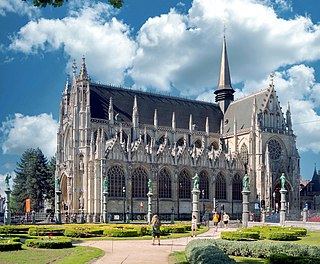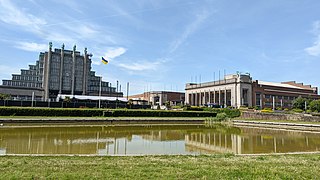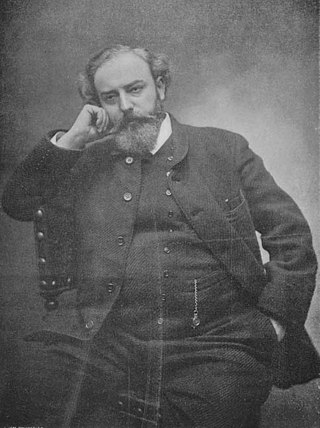
Brussels, officially the Brussels-Capital Region, is a region of Belgium comprising 19 municipalities, including the City of Brussels, which is the capital of Belgium. The Brussels-Capital Region is located in the central portion of the country and is a part of both the French Community of Belgium and the Flemish Community, but is separate from the Flemish Region and the Walloon Region, located less than 4 kilometres (2.5 mi) to the south. Historically Dutch-speaking, Brussels saw a language shift to French from the late 19th century. Nowadays, the Brussels-Capital Region is officially bilingual in French and Dutch, although French is the majority language and lingua franca. Brussels is also increasingly becoming multilingual. English is spoken widely and many migrants and expatriates speak other languages as well.

The Royal Concertgebouw is a concert hall in Amsterdam, Netherlands. The Dutch term "concertgebouw" translates into English as "concert building". Its superb acoustics place it among the finest concert halls in the world, along with Boston's Symphony Hall and the Musikverein in Vienna.

The Vrije Universiteit Brussel is a Dutch and English-speaking research university located in Brussels, Belgium. It has four campuses: Brussels Humanities, Science and Engineering Campus, Brussels Health Campus, Brussels Technology Campus and Brussels Photonics Campus.

The Royal Theatre of La Monnaie is an opera house in central Brussels, Belgium. The National Opera of Belgium, a federal institution, takes the name of this theatre in which it is housed—La Monnaie in French or De Munt in Dutch—referring both to the building as well as the opera company. As Belgium's leading opera house, it is one of the few cultural institutions to receive financial support from the Federal Government of Belgium. Other opera houses in Belgium, such as the Vlaamse Opera and the Opéra Royal de Wallonie, are funded by regional governments.

The City of Brussels is the largest municipality and historical centre of the Brussels-Capital Region, as well as the capital of the Flemish Region and Belgium. The City of Brussels is also the administrative centre of the European Union, as it hosts a number of principal EU institutions in its European Quarter.
The Parc du Cinquantenaire or Jubelpark is a large public, urban park of 30 ha in the easternmost part of the European Quarter in Brussels, Belgium.

Brussels Park is the largest urban public park in central Brussels, Belgium. Formerly known and still sometimes colloquially referred to as the Royal Park, it was the city's first public park, being originally laid out between 1776 and 1783 in a neoclassical style by the French architect Gilles-Barnabé Guimard and the Austrian landscape architect Joachim Zinner, as part of an urban project including the Place Royale/Koningsplein. The area of the rectangular park is 13.1 ha.

The Egmont Palace, also sometimes known as the Arenberg Palace, is a neoclassical palace in Brussels, Belgium. It was originally built between 1548 and 1560 for Countess Françoise of Luxembourg and Count Lamoral of Egmont, though its appearance was heavily modified in the 18th and 19th centuries. It was partly destroyed by fire in 1892, after which it was once again reconstructed. Nowadays, it is used by the Belgian Ministry of Foreign Affairs for receptions, as a guest house and conference centre.

The Royal Conservatory of Brussels is a historic conservatory in Brussels, Belgium. Starting its activities in 1813, it received its official name in 1832. Providing performing music and drama courses, the institution became renowned partly because of the international reputation of its successive directors such as François-Joseph Fétis, François-Auguste Gevaert, Edgar Tinel, Joseph Jongen and Marcel Poot, but more because it has been attended by many of the top musicians, actors and artists in Belgium such as Arthur Grumiaux, José Van Dam, Sigiswald Kuijken, Josse De Pauw, Luk van Mello and Luk De Konink. Adolphe Sax, inventor of the saxophone, also studied at the Brussels Conservatory.

The Eurovision Young Musicians 1992 was the sixth edition of the Eurovision Young Musicians, held at Cirque Royal in Brussels, Belgium on 9 June 1992. Organised by the European Broadcasting Union (EBU) and host broadcaster Radio Télévision Belge Francophone (RTBF), musicians from eight countries participated in the televised final. Eighteen countries took part in the competition. All participants performed a classical piece of their choice accompanied by the Belgian National Orchestra, conducted by Ronald Zollman. Hungary and Poland made their début, while Greece and Italy decided not to participate.

The Royal Museum of the Armed Forces and Military History, also known as the Royal Military Museum, is a military museum that occupies the two northernmost halls of the historic complex in the Parc du Cinquantenaire/Jubelpark in Brussels, Belgium. This site is served by the metro stations Schuman and Merode on lines 1 and 5.

The Vauxhall of Brussels, otherwise known as the Waux-Hall, is a historic performance hall in Brussels Park in Brussels, Belgium. It is named after the pleasure gardens of Vauxhall in London, which only became known to the inhabitants of Brussels in 1761, when a ballet entitled Le Phaxal was put on at the Theatre of La Monnaie. In Paris, the stage-builder Torré opened a "garden of amusements" in 1764, which the public came to call the Vaux-Hall de Torré. A Vaux-Hall d'hiver was set up in 1769 at the Foire Saint-Germin.

The Church of St. James on Coudenberg is a Roman Catholic church located on the historic Place Royale/Koningsplein, in the Royal Quarter of Brussels, Belgium. It is dedicated to Saint James, one of the Twelve Apostles of Jesus.

The Royal Theater Carré is a Neo-Renaissance theatre in Amsterdam, located near the river Amstel. When the theatre was founded in 1887, it was originally meant as a permanent circus building. Currently, it is mainly used for musicals, cabaret performances and pop concerts. Carré is located next to the Amstel, close to Waterlooplein. Its address is Amstel 115 and has approximately 1,700 seats.

The Sablon or Zavel is a neighbourhood and hill in the historic upper town of Brussels, Belgium. At its heart are twin squares: the larger Grand Sablon or Grote Zavel square in the north-west and the smaller Petit Sablon or Kleine Zavel square and garden in the south-east, divided by the Church of Our Blessed Lady of the Sablon. This area is served by Brussels-Chapel railway station and Brussels-Central railway station, as well as the tram stop Petit Sablon/Kleine Zavel.

The Brussels Exhibition Centre, also known as Brussels Expo, is the most important event complex in Brussels, Belgium. Located on the Heysel/Heizel Plateau in Laeken, the twelve halls that comprise it are used for the largest national and international trade fairs, exhibitions and other events. With 115,000 m2 (1,240,000 sq ft) of facility space, they constitute the largest exhibition space in the Benelux. They are also a remarkable witness to the evolution of construction techniques during the 20th century.

Albert Émile Clément Dubosq is one of the most prolific Belgian scenographers of the Belle Époque. Between 1890 and 1925 Dubosq decorated 446 theatrical entertainments of virtually every possible kind: ballet, circus, (melo)drama, opera, operetta, pantomime, revue, and vaudeville. Dubosq is furthermore one of the few scenic painters of his generation to have left a substantial sample of his art, namely twenty-one (near-)complete sets. Comprising Europe's largest holding of historical decors, the hundreds of flats and drops of the ‘Dubosq’ collection have survived at the Schouwburg of Kortrijk since 1920.
The Antwerp Symphony Orchestra is the symphony orchestra of Flanders (Belgium), based in the Queen Elisabeth Hall in Antwerp. The orchestra is led by chief conductor Elim Chan and honorary conductor Philippe Herreweghe. The organisation, which is one of the seven art institutions of the Flemish Community, is one of the most important cultural representatives in the region. It is one of only two Belgian orchestras that have the right to style themselves as "royal", hence its full name "Antwerp Symphony Orchestra - the royal philharmonic orchestra of Flanders".

The Flagey Building also known as the Radio House is a building located in Ixelles, a municipality of Brussels, Belgium, housing the Flagey cultural centre. It is located on the south-western corner of Place Eugène Flagey/Eugène Flageyplein, with its main entrance on the Place Sainte-Croix/Heilig-Kruisplein.

KANAL - Centre Pompidou is a museum for modern and contemporary art located in Brussels, Belgium, near the Brussels–Charleroi Canal, in the former buildings of a Citroën garage. The definitive opening is scheduled for 2025. During the renovations, the museum remains open at its temporary location K1, at 1, avenue du Port/Havenlaan.





















